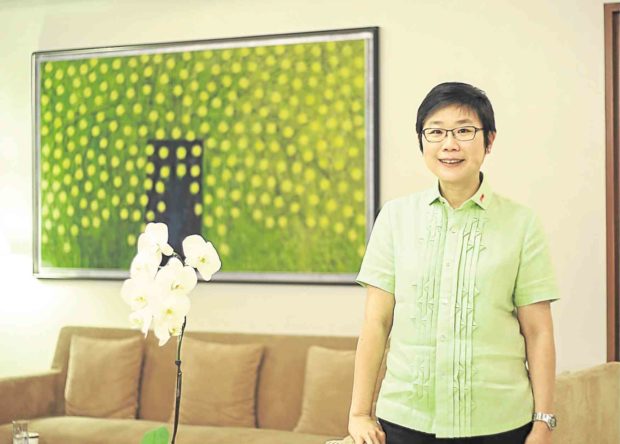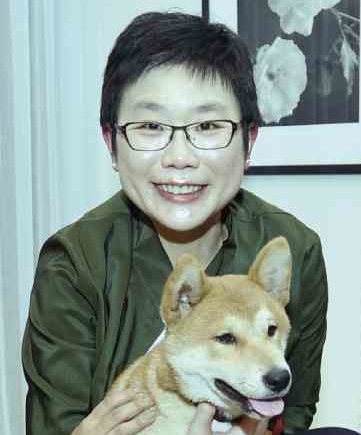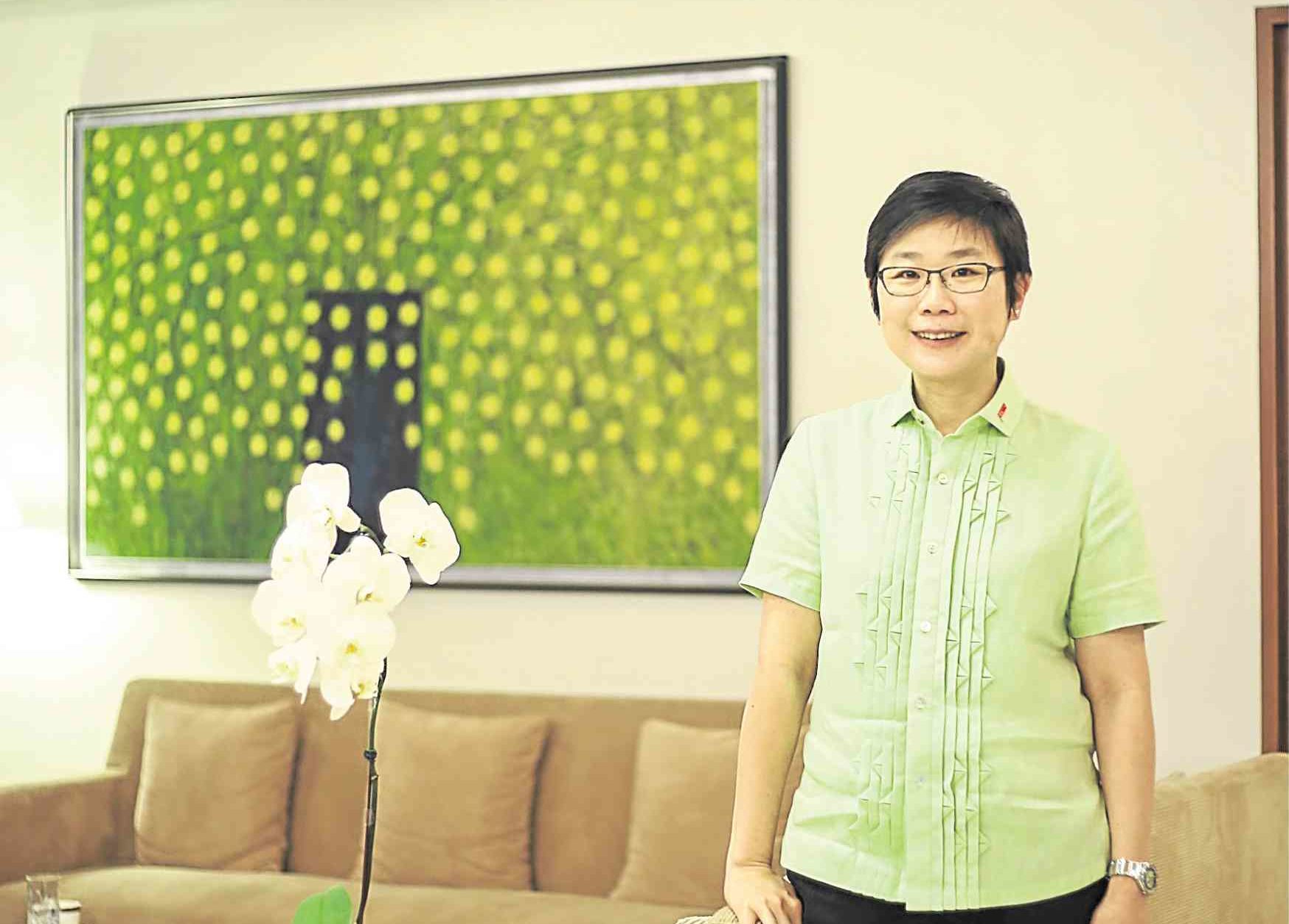
artist Manjeet Shergill
In her art-filled residence, Singapore Ambassador Kok Li Peng greeted us in a green polo barong by Silk Cocoon, and invited us for merienda.
The meal was cross-cultural, an array of Korean-Mexican tacos from Vatos Urban Tacos and pillowy ensaymada from Mary Grace.
Ambassador Kok is a foodie and enjoys Filipino cuisine. She noted how Singaporeans and Filipinos share the love of food. The envoy first tasted sisig at Aracama in BGC and pinakbet at Abe.
Many of her food discoveries are travel-related. In Iloilo, where she attended the meeting of trade ministers of the Asia-Pacific Economic Cooperation, she tried and liked batchoy. “You have to exercise a lot afterward,” she remarked.
In Dumaguete, she visited Silliman University and Negros Oriental State University, and walked along the scenic Rizal boulevard.
“We tried the original sans rival, and were told that the original was hard to find outside,” she said. “We bought stacks of pasalubong for the staff and they were happy.”
Ambassador Kok savored Kapampangan food in Claude Tayag’s diner, Downtown. “The food was so good that we went back,” she said.
At a friend’s dinner party, the bangus and the bangus belly left a lasting impression on her.
Locals brag to her that their province or town has the best version of sisig and crispy pata.
“Each province vies for the title ‘best specialty,’ and I’m happy to try them all,” she said.
Different issues
The Philippines is her first posting as an ambassador. She joined the Singapore Ministry of Foreign Affairs in 1995, working for the International Organizations Division.
“The nature of the job is to rotate through a series of portfolios so you cover different issues,” Kok said.
She then covered the Asean beat for the ministry and was posted as First Secretary to Washington in 1999. She returned to Singapore in 2002, and took a year off for study.
In 2008, she went to New York as deputy permanent representative in the Singapore Mission to the United Nations. Four years later, she became the director general for the Asean at the Ministry.
Three years ago, she became madame ambassador.
“Being an ambassador comes with a new set of responsibilities,” she said. “It has been a bit of challenge. You’re suddenly the flag bearer of the country. Previously, I was playing supporting role to the ambassador. You’re careful of how you behave and what you say. You’re aware that eyes are on you at all times,” she said.
The envoy arrived in the Philippines in 2015, when the country hosted the Apec Leaders’ Summit.
“There was a social media contest for the best-looking heads of state,” she recalled.

The diplomat discovered more about the Philippines during the 2016 elections. Later in the year, President Duterte made a state visit to Singapore.
“It was a good start of our bilateral relations. It cemented our friendship,” she said.
Best possible posting
“It’s fun that the Philippines is the best possible posting for an ambassador,” the envoy said. “There is a wide variety of work, from issues like political, military and security, and trade, to culture issues.”
During the Marawi crisis, Singapore offered assistance to agencies during the siege. It also expressed interest in helping rebuild Marawi.
“As my prime minister said, ‘We are in this together.’ We are all part of the region. We’ve got to help each other. We helped during the active phase, we provided humanitarian assistance. We provided training for the Armed Forces of the Philippines in terms of urban warfare. We are actively talking to Bangon Marawi.”
In trade, Singapore is the Philippines’ largest training partner, and the largest training partner in the Asean.
“We are happy to see that Filipino companies are also coming to Singapore,” she said. “The Philippines is strong in agri business, such as fresh produce. We are looking into areas of design and services which are in great demand in Singapore. Thirty percent of my work is trade diplomacy.”
In terms of cultural ties, Kok attends concerts and art exhibits. She waxed enthusiastic about Bituin Escalante’s performance at Meralco Theater. The diplomat praised Filipinos as artists and craftsmen. She said that it was one of the few countries in the world which bestowed honors on its National Artists.
Local travel
Her work has also taken her to Davao, Cagayan de Oro and Cebu. “Part of our job is finding business opportunities for Singapore and getting to know the people,” she said.
“Every time I visit a new place, I say hello to the governor, the mayor and the local chamber of commerce. The focus is on building a relationship but we sneak in some sightseeing,” she said with a naughty grin.
Ambassador Kok enjoyed the diversity of Bohol—Baclayon Church, Loboc Children’s Choir, the river cruise and the tarsiers.
“The Chocolate Hills were more minty green that season,” she said. “Bohol’s tourism potential is big—friendly people, good infrastructure, many attractions and clear waters.”
She took a vacation in El Nido, Palawan, where she and her friends went island-hopping.
Before his death last May, Sen. Edgardo Angara would invite diplomats to the Philippine-Spanish Friendship Day festivities in his home province, Baler. She visited the San Luis Obispo de Tolosa church where the Philippine soldiers were holed up during the Siege of Baler by the Spaniards.
Throughout her tenure, which has been extended to the end of the year, Ambassador Kok has been conversing with friends, trying to understand the culture.
“If there is breaking news, I call my friends. What does this mean? What are the context and the factors that I should be looking at? How do we share our interpretation and analysis? I would be gently corrected if my observations were off-tangent. I’ve learned a lot.
“I’ve had to step up my EQ (emotional quotient) and improve my CQ (cultural quotient), according to one of my mentors, Ambassador-at-Large Tommy Koh. It’s important for diplomats to understand the culture of the host country. You pick up nuances which you might otherwise miss.”
She was informed about the Filipino nature of not wanting to offend others.
“Filipinos are the politest people I’ve ever met. I’m a direct person. I’m used to people telling me, ‘Ambassador or Li Peng, you went too far there.’ Here, it’s more subtle.”
Pinoy phrases
Asked if she had picked up Tagalog words, Ambassador Kok said she had, and noted that our language has Malay words.
“My favorite phrase is ‘Mahal kita.’ It’s a clever pun. Mahal means love and mahal means expensive in Malay. Love is expensive,” she said.
She also learned walang pasok (no work), walang problema (no problem) and kuripot (stingy). I asked what it meant. “That had better not be implied on me,” she said.
After 23 years in the diplomatic service, the ambassador is enjoying single-blessedness.
“I respect the institution of marriage, but I’m not sure I’m cut out for it.”
Asked what she would take home from the Philippines aside from the paintings by young artists, she replied, “An appreciation of resilience and a softer approach to overcoming challenges.”
How would she rate her cultural quotient during her tenure?
“A passing grade,” she said. “The more I learn about Filipino culture, the more I don’t know. The country is 120 years old. Before that you had a long (Spanish colonial) history. The norms and the ways Filipinos interact are very complex. Staying here for nearly four years is just the tip of the iceberg. It’s how not to fall flat on your face,” she said with a chuckle. —CONTRIBUTED













































